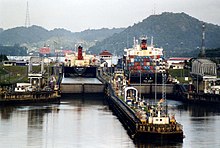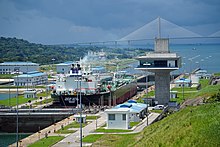
Back Panamax Catalan Panamax Danish Panamax German Παναμάξ Greek Panamax Esperanto Panamax Spanish پاناماگذر Persian Panamax Finnish Panamax French Panamax Galician
| General characteristics Panamax | |
|---|---|
| Tonnage | 52,500 DWT |
| Length | 289.56 m (950 ft) |
| Beam | 32.31 m (106 ft) |
| Height | 57.91 m (190 ft) |
| Draft | 12.04 m (39.5 ft) |
| Capacity | 5,000 TEU |
| Notes | Opened 1914 |
| General characteristics New Panamax | |
|---|---|
| Tonnage | 120,000 DWT |
| Length | 366 m (1,201 ft) |
| Beam | 51.25 m (168 ft) |
| Height | 57.91 m (190 ft) |
| Draft | 15.2 m (50 ft) |
| Capacity | 14,000 TEU |
| Notes | Opened 2016 |


Panamax and New Panamax (or Neopanamax) are terms for the size limits for ships travelling through the Panama Canal. The limits and requirements are published by the Panama Canal Authority (ACP) in a publication titled "Vessel Requirements".[1] These requirements also describe topics like exceptional dry seasonal limits, propulsion, communications, and detailed ship design.
The allowable size is limited by the width and length of the available lock chambers, by the depth of water in the canal, and by the height of the Bridge of the Americas since that bridge's construction, along with the clearance under the Atlantic and Centennial Bridges since their constructions in 2019 and 2004 respectively. These dimensions give clear parameters for ships destined to traverse the Panama Canal and have influenced the design of cargo ships, naval vessels, and passenger ships.
Panamax specifications have been in effect since the opening of the canal in 1914. In 2009, the ACP published the "New Panamax" specification,[2] which came into effect when the canal's third set of locks, larger than the original two, opened on 26 June 2016. Ships that do not fall within the Panamax-sizes are called post-Panamax or super-Panamax.
The increasing prevalence of vessels of the maximum size is a problem for the canal, as a Panamax ship is a tight fit that requires precise control of the vessel in the locks, possibly resulting in longer lock time, and requiring that these ships transit in daylight. Because the largest ships traveling in opposite directions cannot pass safely within the Culebra Cut, the canal effectively operates an alternating one-way system for these ships.
- ^ "Vessel Requirements" (PDF). Panama Canal Authority. Archived from the original (PDF) on 2021-12-28. Retrieved 2005-05-16.
- ^ Manuel E. Benítez, ACP (2009-01-19). "Dimensions for Future Lock Chambers and "New Panamax" Vessels" (PDF). ACP. Archived from the original (PDF) on 2009-05-06. Retrieved 2010-05-02.
© MMXXIII Rich X Search. We shall prevail. All rights reserved. Rich X Search